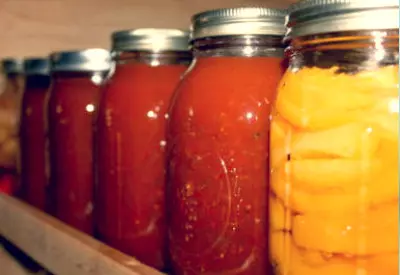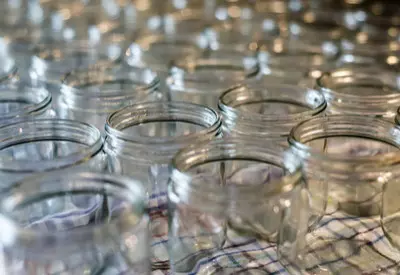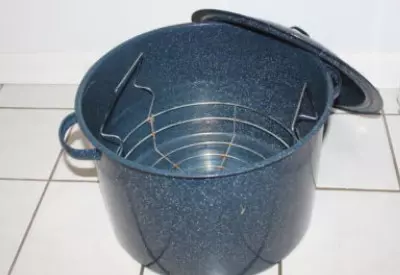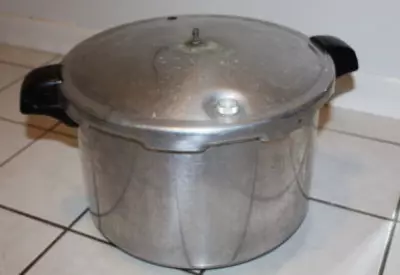With canning season in full force, we receive several emails, Facebook messages and even phone calls every day on questions that pertain to canning.
These questions range from a simple request for our favorite pickle recipe to how to can green beans without a pressure canner.
We try to answer each and every question and we are guessing there are probably even more questions out there.

So this week we thought it would be a good time to go over our top tips to get you safely through canning season.
1. Prepare All Equipment Before Getting Started
Each time you get started, be sure to have everything you are going to need on hand and within close proximity.
There is nothing worse than being at a crucial point in the canning process and realize that you are missing a piece of equipment. You begin to panic as you try to figure out where it is, all while trying to salvage whatever it is that you are canning.
We have a Ball Utensil Kit that we store all together in the same spot year after year. It consists of a canning funnel, jar lifter, a plastic tool to release air bubbles and my favorite tool: the magnetic lid lifter.

I don’t know what I would do without these tools! They save me time, but most importantly prevent me from scalding my hands during the canning season.
Next be sure to have enough Mason jars for what you are planning to can. Be sure to check them for any chips or cracks before you sterilize them. If they have any blemishes, recycle them or use them for another purpose.
What most people forget to check, especially in the middle of canning season, is the supply of lids that you have on hand. Be sure to check to see how many wide mouth or regular mouth lids that you will need.
And of course, don’t forget to inspect the rings as well. How many times have you had difficulty opening the jar and used a knife to knock it loose. It might be time to get some new rings as well!
Most Important Of All…
And most importantly, be sure to sterilize your equipment before using them to help prevent any cross-contamination during the canning process.
We use an electric roaster filled with water to sterilize our jars and rings. We could use the dishwasher, but for us, we find it easier to keep everything above the counter. The electric roaster is also a good idea because it is one less thing that is on the stove top!
Now that you are ready to get started, here is the next important tip for canning season:
2. Follow A Specific Recipe
Now is not the time to put your culinary skills to the test. Canning is truly a science and there is a direct correlation of the amount of acid that is in your food to how and how long it needs to be processed.
And just because Grandma canned tomatoes a certain way, doesn’t mean that you should.
The properties of food, yes, even garden produce, has changed over the years. This makes Grandma’s canning recipes and methods at risk of no longer being safe to consume.
The best and most trusted way to get a lab tested, safe to consume recipe is through the National Center for Home Food Preservation, USDA approved website. Also, most state extension offices have published additional recipes that have been tested in a lab as well.
Yes, we have our own canning recipes on this website, but like the disclaimer states, these are recipes that have not been lab tested and by following our recipe you do so at your own risk. Good news – we are still alive and well 🙂
3. Water Bath Canning
Canning season typically begins with those who can by using a water bath. Most jams and jellies, pickles and some salsa recipes are canned this way.

Technically, you could use a large stockpot to try out water bath canning before purchasing a dedicated pot for this purpose. However, I find it much easier to can in our Ball Water Bath Canner. It is wider than a typical stockpot and it has a rack in the bottom for the jars.
If you are going to can more than a few jars or batches, I would definitely recommend the purchase. It will make your job so much easier and that means it is more fun!
The key to water bath canning is to get your water hot enough, but not yet boiling, by the time you are ready to lower your jars in the pot.
This will ensure that the food in the jars doesn’t get over heated while waiting for the pot to come to a boil.
Also, be sure to have about 2 inches of water above the tops of the jars. This will allow the entire jar to be under boiling water for the required time.
4. Pressure Canning
Forget the horror stories of kitchens blowing up because a pressure canner was used. The pressure canners out there today are much different that what Grandma and Mom had.

There are two types of pressure canners: Dial-Guage and Weighted Pressure Canners. Both are completely safe to use when you follow the operating instructions.
In our home we have the Presto Weighted Pressure Canner. I have used it for years and it has worked extremely well for me.
I like to keep my instruction manual inside the pot when it is not in use. This may seem silly, but after it has been in a closet for 6 months, I like a quick 2 refresher before using it again.
And if you don’t have your manual, I am sure it can be found on the internet.
Be sure to check the seal and valve each time before canning. The seal must be tight and in place correctly for the pot to come to pressure. And the valve must be clear for the steam to release properly.
We use our pressure canner for 75% of all of our canned goods. It’s a quicker and safer way to can many items from the garden including tomato juice, pasta sauce, green beans, and more!
Just in case you are wondering if the Instant Pot Pressure Cooker can do pressure canning….the answer is No, not yet. There are rumors that a new version of the Instant Pot will be coming out soon and that is rumored to be one of the newest features.
5. Use Only Fresh Picked Vegetables Without Blemishes
Now is not the time to use those over-ripened or damaged vegetables. If you can with them, the end result is going to taste the same way.
This is especially true when making pickles. Cucumbers that have been sitting around for a few days will not make good crisp pickles. And be sure to use small pickling cucumber varieties and not large cucumbers that have a large seed core.
It is okay to cut off small blemishes from tomatoes when canning but inspect the entire tomato because there could be more damage somewhere else that is harder to see.
6. The After Canning Process
Once you remove your jars from the canner be sure to place them on a thick towel and let them cool upright for 24 hours. That means no touching or moving them around until the next day.
This is a crucial time to make sure that your jars seal properly. Excessive movement may cause the jars to not to seal at all.
After 24 hours push down on the center lid. If you are able to push down and it bounces back up (you will hear a clicking noise), that jar is not shelf-stable.

But all effort is not wasted. You can put it in the refrigerator and it is still safe to eat. It’s just not safe to sit in your pantry.
Once you have determined that all of your jars have sealed properly, you can remove the outer ring if you wish. This ring is designed to hold the lid in place until it seals. One the jars are sealed, there is no longer a need for the ring.
Final Thoughts…
And finally – label your jars with not only the contents but also the month/year and batch number (if applicable). The batch number is important when you taste the contents of that jar and determine there is an issue.
Not only do I mean if it doesn’t taste right, but also if you made a batch that was spicier than you thought. Now you will know that each jar labeled with that batch number will be spicy as well.
So there you have our 6 Tips To A Successful Canning Season!
Feel free to add in your own tips in the comment section or on Facebook for everyone to benefit from!
Mary and Jim
Jim and Mary Competti have been writing gardening, DIY and recipe articles and books for over 15 years from their 46 acre Ohio farm. The two are frequent speakers on all things gardening and love to travel in their spare time.
As always, feel free to email us at thefarm@owgarden.com with comments, questions, or to simply say hello! You can sign up for our free email list in the subscribe now box in the middle of this article. Follow us on Facebook here : OWG Facebook. This article may contain affiliate links.
